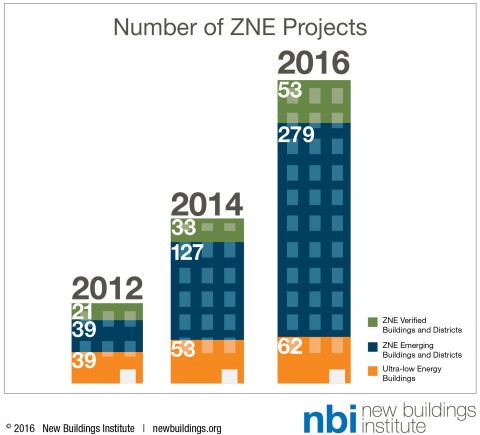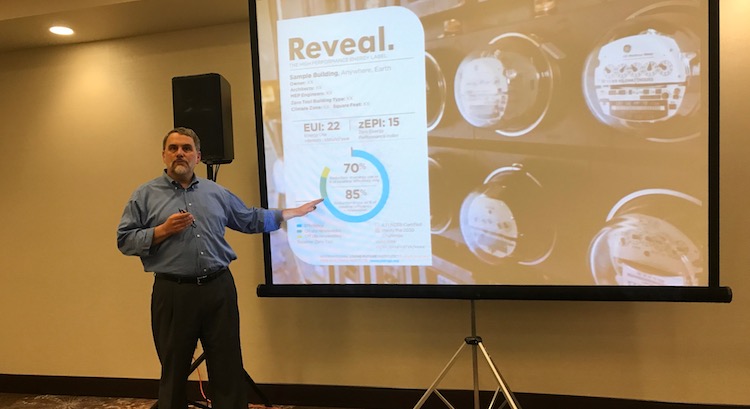The International Living Future Institute’s reboot of its Net Zero Energy program is more than a name change. It establishes NZE’s replacement — Zero Energy Building Certification— as the sole standard for an achievement that’s increasingly common among high-performance buildings.
“We want to get Zero Energy to be the new normal,” ILFI CEO Amanda Sturgeon told a Living Future 2017 audience earlier this month as she unveiled the new program. Sturgeon added that she hopes ZE certifications soon will number into the thousands.
ZE is a collaboration with the New Buildings Institute, which advocates for improved energy performance in commercial buildings and has been tracking net zero buildings since 2000. The Portland nonprofit will continue to track zero energy projects and will serve as the chief auditing agent for projects that are going for certification. ILFI will administer the certification program. The two organizations also are planning to operate a joint portal for zero energy buildings, which is still under development.
According to an ILFI post detailing the changes:
… NBI and ILFI will consolidate certified, verified and emerging ZE building projects into a single, unified dataset with common categories. In addition, NBI and ILFI will also share a protocol for data collection, certification and case studies. The partnership builds on the strengths of each organization, and the end result will be one seamless system for tracking, registering, certifying, and evaluating the burgeoning zero energy movement. The buildings industry—design teams, builders, owners, operators and others—will also get the needed clarity on the standards for zero energy performance using data driven outcomes for validation.
The reboot comes as improved solar, lighting, HVAC and building-envelope technology have put zero energy within reach for more and more buildings. At the end of 2016, NBI’s Getting to Net Zero Database included 53 buildings that were “verified” to produce more renewable energy than the total energy they used over the course of a year. Another 279 were classified as “emerging” — meaning they’re designed to attain zero energy but haven’t yet performed at that level for a full year.

Over the last two years, the combined number of “verified” and “emerging” buildings has more than doubled. But those buildings have been focused in particular sectors, such as K-12 education. They still represent a tiny fraction of all new structures.
“There’s not necessarily a market for zero energy buildings,” NBI CEO Ralph DiNola stressed at a workshop last week detailing the new program. “So we need to help to create a market.”
Toward that end, the new standard eases the path toward certification. For example, the old NZE standard required projects to fulfill three Living Building Challenge’s Imperatives: Limits to Growth, Beauty, and Inspiration and Education. Those no longer are mandated. In addition, certification no longer requires a site audit.
Fees also have dropped. Certification now runs $1,250 for a home and $2,000 for a commercial property, in addition to a $900 application fee.
The program continues to be founded on a basic, documented standard: “12 consecutive months of zero energy performance for a project, without the use of onsite combustion.” But ZE also allows projects — under very limited circumstances — to supplement onsite renewable energy with renewable energy generated offsite. The Offsite Renewables Exception applies only to buildings in tight urban areas (where there isn’t enough room for solar panels), to leased offices in larger buildings, or to locations where the utility refuses to buy back excess power. For the exemption to be granted, a documented effort must have been made to overcome any of these conditions, offsite production must have been constructed specifically for the building, and the project must hold a contract to secure the energy for at least 10 years
DiNola and ILFI Net Zero Energy Director Brad Liljequist (pictured above) acknowledged that another topic turned out to be a difficult issue. The two organizations spent a lot of time discussing the use of natural gas in Zero Energy projects. ILFI prohibits combustion, but has allowed narrow exceptions (for stoves and emergency generators, for example). NBI has been more permissive. Liljequist said the new standard will continue to allow narrow exceptions on a case-by-case basis. As technology advances the viability of Zero Energy, however, the two organizations have agreed to continue to discuss the issue further.
 Eliminating requirements for three imperatives widens the difference between Zero Energy certification and the Living Building Challenge’s Energy Petal certification, which would help to clarify the market for each program. The Energy Petal is more arduous because it requires net positive performance, onsite energy storage and the attainment of at least two other petals. At the same time, projects seeking the Energy Petal may also now apply for the limited offsite exception.
Eliminating requirements for three imperatives widens the difference between Zero Energy certification and the Living Building Challenge’s Energy Petal certification, which would help to clarify the market for each program. The Energy Petal is more arduous because it requires net positive performance, onsite energy storage and the attainment of at least two other petals. At the same time, projects seeking the Energy Petal may also now apply for the limited offsite exception.
The working relationship with NBI also includes a revamped ILFI’s Reveal label, which highlights a building’s documented energy performance. The label now includes more baseline information, as well data that places the building’s progress in terms used by NBI and Architecture 2030.
CORRECTION: This article has been changed to more accurately reflect the status of combustion and natural gas in Zero Energy certification.



This article is ridiculous and rubbish not to mention an improper use of the English language.
1. “Zero Energy” and “Zero Net Energy” implies NO ENERGY!
2. EVERYONE in homes and buildings NEED energy.
3. “Zero Energy” and “Zero Net Energy” are non-sensical words and do NOT mean what this author is trying to convey and CONFUSE most people including builders, homebuyers, energy utilitues and even energy / renewable energy professionals.
4. The CORRECT terminology is #NetZeroEnergy and used by the leading companies in the energy/renewable energy, building and governmental sectors including:
> Tesla
> Meritage Homes
> US Army
> Navigant Consulting
> Austin, Texas – 1st city to mandate “Net Zero Energy” which started Jan. 1, 2015.
> Whisper Valley – a $2 billion real estate development in Austin, Texas and the world’s largest “Net Zero Energy” community.
and many cities and countries around the world including:
Boulder, Colorado
Burlington, Vermont
Lancaster, California
San Luis Obispo, CA
Australia
Germany
Japan
among many others.
#ZeroEnergy and #ZeroNetEnergy are DEAD!
Long live #NetZeroEnergy!